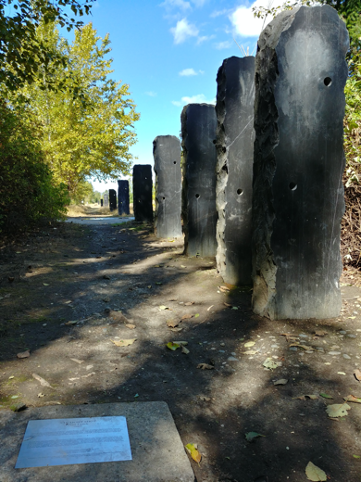
This is public art (and science). Like all good art it’s unique and thought provoking. It sits in one of the less visited corners of Magnuson Park (the old Sand Point Naval Air Station) in Seattle.
Briefly… the artist, Perri Lynch, crafted 12 limestone pillars along a 1- kilometer line called the Sand Point Calibration Baseline where surveyors’ measure, test, and calibrate their equipment. There are about a dozen such baselines in the State of Washington, but some local surveyors worried that this one would be destroyed by unknowing visitors. They lobbied for public art monument to raise awareness and prevent its accidental destruction.
The Office of Arts & Cultural Affairs and Seattle Public Utilities commissioned the work in 2007 with $40,000 from SPU’s One Percent for Art fund. A surveyors association and a private survey-equipment company also contributed.
Its nickname is Linehenge; a 10-foot-wide, kilometer-long swath straight through Magnuson Park from south to north, it goes unnoticed by thousands of people every day. The accuracy of the Sand Point line is said to be within half a millimeter. Lynch also played with perspective, doubling the distance between one pillar to the next in the line with each one having a small peep hole sighted along the line.
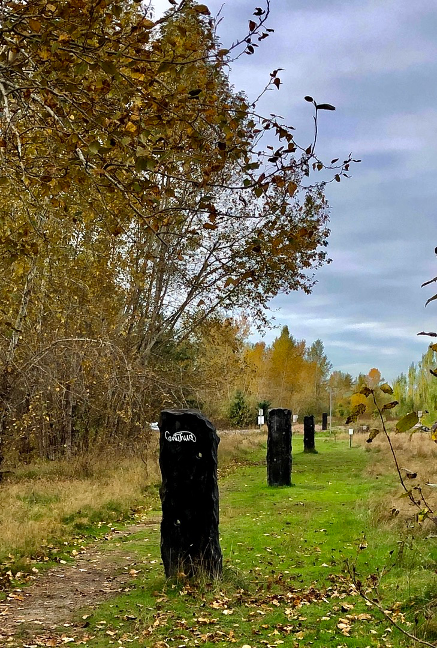
M and I discovered it on a walk through the park earlier this week and wanted to know more. It has its own Wikipedia page with information about the art and artist – but it doesn’t mention that several of the pillars have been defaced with graffiti “tags.” It pisses me off. I don’t get it but it’s only the latest example of the rant/rage response I feel when I see graffiti on the side of monuments, buildings, homes, and road signs. I’m probably making more of it than I should, but it seems disrespectful and a symptom of something bigger. Probably a more complicated social problem – one that may reveal a something about me I’d rather not look closely at.
That problem, as I see it, is the way Seattle parks, playgrounds, and city sidewalks are being taken over by the homeless.
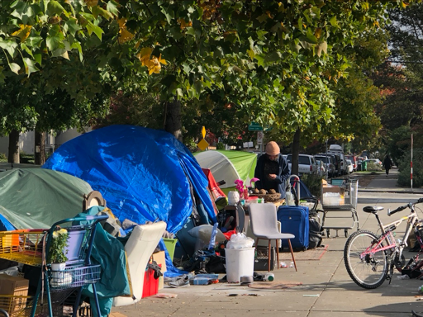

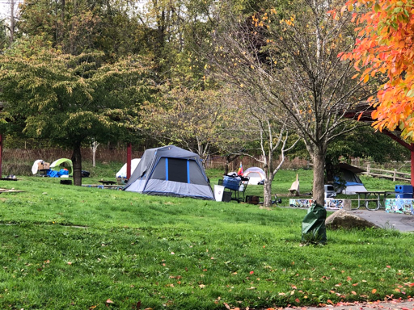
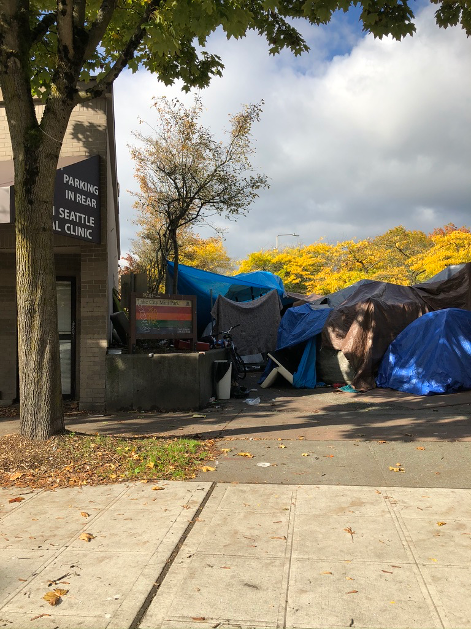
My heart goes out to Seattle’s ever-growing homeless population. I know it’s not their choice to live in squalor without running water and proper sanitation. On the other hand, I hate the idea that parent’s can’t feel safe taking their children to a playground filled with homeless tents and vagrant-looking men? On Thursday around noon, M and I watched a man urinate in the center of a circle of tents at Albert Davis Park in Lake City.
For two weeks, we’ve been driving around to see various encampments. Over the last 3-5 years we’ve watched them grow along the sides of I-5, as garbage and litter spread along the hillsides, and tents appeared under the freeway at James Street and along Alaskan Way. Now their tents are taking over city parks and rundown RV’s, are parked in clusters near Fred Meyer in Ballard and the stadiums in SODO. The police have given up enforcing the health and safety ordinances. It’s the Wild West again.
I came of age as a student in the People’s Republic of Berkeley, but the Seattle City Council makes Berkeley look like a bunch of rubes – defunding the police, forcing the resignation of Chief Carmen Best, dismantling a specially trained Navigation Team, composed of outreach workers paired with Seattle Police Department (SPD) personnel that connected unsheltered people to housing and critical resources, and bitching at the mayor.
What does the Sand Point Calibration Baseline have to do with the homeless problem? Very little, but I see its defacing graffiti as a symptom of the bigger problem. Our roads and bridges are falling apart, roadsides and median strips are untended, garbage covers I-5 sidehills, and the homeless are urinating and defecating in city parks. Government has let us down and we no longer trust that it will be there for us.
Income inequality is tearing at the social fabric. No one wants to pay taxes; the poor can’t afford to, the rich don’t have to, and those who control the public purse are hiding behind the rubric of “fiscal responsibility.” Now they’re blaming the pandemic for their inaction and our plight. City, county, and state coffers are drained and Seattle looks more and more like Cormac McCarthy’s post-apocalyptic cities with roving nihilistic provocateurs providing fodder for the Trump law and order campaign.
Wouldn’t it be nice if we all had Bill and Melinda’s resources? They almost conquered smallpox, but even they can’t do what we need government writ large to do. They’re doing their part though QAnon is even throwing shade their way – another example of lack of respect and trust.
M and I would have been great philanthropists. We know it. We talk about it. We fantasize. But, we will do what we can within the system. We’ll vote. We’ll express our opinion. We’ll make charitable contributions. We’ll exhort our friends to participate, and we’ll write blogs and letters.
After looking at a dozen homeless camps, I had this thought; at the height of New York’s Covid-19 spike in April, a 68-bed field hospital was erected in Central Park. and here in Seattle a 250-bed non-Covid field hospital was established at Century Link Field. Ohers were established in El Paso and other locations across the country. And, they were erected in a matter of days – not months.
Yes, they were an emergency solution to overstressed hospital facilities, but couldn’t they also be deployed to temporarily house the homeless? Wouldn’t it help if we provided them shelter through the winter? Wouldn’t safer, sanitary housing be better than a trashy tarp covered hovel on the sidewalk? Providing shelter doesn’t address the larger problems of mental health, drug dependence, health care, and other social services but it would be a place to start. Shelter first and then work on the rest. We need to look out for each other.
“Twas in another lifetime, one of toil and blood
When blackness was a virtue the road was full of mud
I came in from the wilderness, a creature void of form
Come in, she said
I’ll give ya shelter from the storm”
Bob Dylan (Shelter from the Storm)

It’s worth thinking about.
Epilogue: I wrote the blog post ten days ago. Yesterday this article appeared in the Seattle Times. Apparently, the idea was not so far fetched.
https://www.seattletimes.com/seattle-news/homeless/seattle-king-county-open-large-congregate-shelter-with-salvation-army
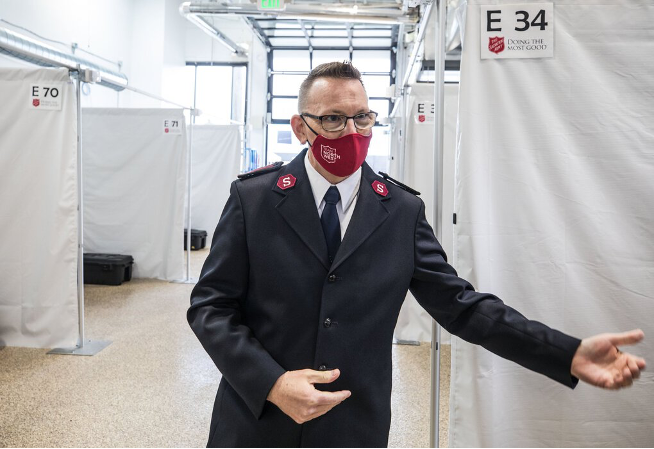
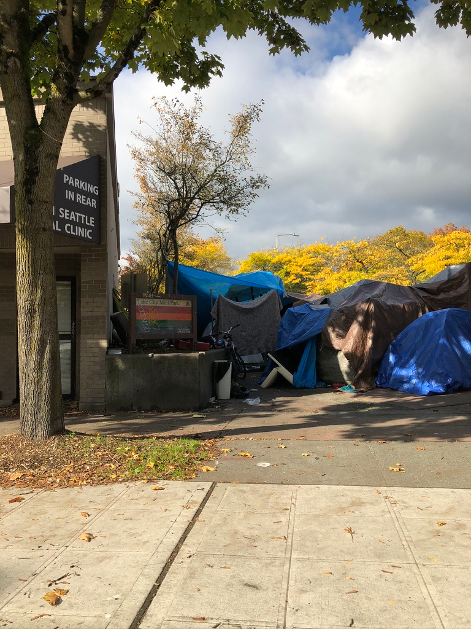
































Jack,
Enjoyed your piece especially since it was near where I grew up (Wedgewood-Bryant-Eckstein). Is the Sand Point Golf Club still there? Important question a/c Hugh Cook will want to know. Mike